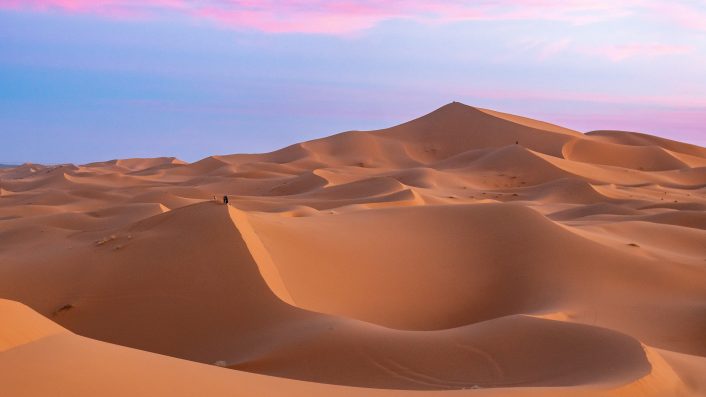The Sahara Desert Flooded For The First Time In Decades After Receiving More Rain In Two Days Than Normally Seen In A Year

The Sahara Desert is one of the most arid, barren places on Earth, but it does receive a few inches of rainfall a year. Over the course of just two days in September, the dry region was hit with its first floods in decades.
Parts of the desert saw nearly eight inches of rainfall after a low-pressure system pushed across the northwestern Sahara, which is more than the area normally receives in an entire year.
The rainfall temporarily transformed the desert terrain, covering sandy dunes and creating a new watery landscape. Drone footage and satellite images from NASA showed large lakes amid the scrubby flora.
Between September 7 and 8, intense rain fell in parts of the desert in Morocco, Tunisia, Algeria, and Libya.
The newly formed lakes from the heavy rainfall make the Sahara look like what it did thousands of years ago before the land became arid due to changing weather patterns.
“It’s been 30 to 50 years since we’ve had this much rain in such a short space of time,” said Houssine Youabeb, a meteorologist at Morocco’s General Directorate of Meteorology.
Residents of towns in the region are amazed by the changes to the landscape. The rain filled up lakes that are usually dry, such as one in Iriqui National Park in Morocco. Before now, the lake bed had been dry as a bone for over 50 years.
A desert city in southeast Morocco called Errachidia, recorded almost three inches of rainfall, with most of it occurring across two days. It equated to more than half a year’s worth of rainfall for the area.
In Tagounite, a village located about 280 miles south of Morocco’s capital, 3.9 inches of rainfall was recorded in a period of just 24 hours.

patxi – stock.adobe.com – illustrative purposes only
Unfortunately, the heavy rainfall also caused deadly flash floods that killed at least 18 people in Morocco’s towns and villages.
In the southeastern Sahara, the rain put a lot of stress on dammed reservoirs and damaged crops, which led to emergency government relief funds being allocated to farmers.
According to experts and meteorologists, more extreme rainfall events can be expected in the Sahara Desert in the future.
As pollution from fossil fuels continues to heat up the planet and increase global temperatures, weather patterns will shift, and the water cycle will be disrupted.
“As a result of rising temperatures, the hydrological cycle has accelerated. It has also become more erratic and unpredictable, and we are facing growing problems of either too much or too little water,” said Celeste Saulo, the Secretary-General of the World Meteorological Organization.
An extratropical cyclone is responsible for the historic rainfall in the Sahara. The cyclone originated in the Atlantic Ocean and gathered moisture from equatorial regions of Africa. Then, it was pushed farther north than usual, leading to a rare downpour in the desert.
Sign up for Chip Chick’s newsletter and get stories like this delivered to your inbox.
More About:News





